|
|
|||||||||||||||||||||||||||||
Soyuz-3: USSR resumes human missions after the accident In October 1968, a year and a half after the fatal Soyuz-1 accident, the new Soviet spacecraft finally returned to flight with a pilot onboard. Right after entering orbit aboard Soyuz-3, a cosmonaut Georgy Beregovoi began manual approach to unpiloted Soyuz-2, but made crucial errors in the darkness of night trying to dock in upside down orientation and severely overusing propellant. The failed manual docking after two successful automated rendezvous missions delivered many lessons for future of human space flight.
Previous chapter: Soyuz-1 mission
Joint mission of Soyuz-2 and Soyuz-3 at a glance:
|
Want to take a look behind the scene of the latest space flight effort? |
||||||||||||||||||||||||||||
| PREPARING SOYUZ-2 AND -3 MISSION | |||||||||||||||||||||||||||||
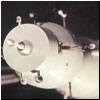 |
Planning the Soyuz-2 and -3 dual mission At the end of May 1968, on instructions from the Kremlin, the Chief Designers Council adopted the most conservative flight program on the table: an unpiloted solo mission followed by the rendezvous and docking of two Soyuz spacecraft, with only one pilot on the vehicle responsible for active docking maneuvers. |
||||||||||||||||||||||||||||
 |
After the approval of the 0+1 flight scenario, there was the obvious contentious question of who would pilot the "active" ship intended to dock with the automated target vehicle. Head of cosmonaut training Nikolai Kamanin pushed for Georgy Beregovoi, a prolific test pilot and the oldest member of the Soviet cosmonaut team. Beregovoi had served under Kamanin as a pilot of the Il-2 anti-tank aircraft during World War II. |
||||||||||||||||||||||||||||
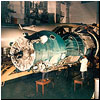 |
Preparing Soyuz-2, -3 for flight In the middle of October 1968, the top-secret Soviet launch site near Tyuratam (Baikonur) saw a major gathering of top officials for the dual Soyuz launch. The preparation campaign had entered into the full gear with the rollout of Vehicles No. 11 and No. 10 to Site 1 and Site 31 on October 23 and 24, respectively. Georgy Beregovoi got the final endorsement as the only pilot in the dual mission. |
||||||||||||||||||||||||||||
 |
The planned Soyuz-3 mission got a very ambitious "front-loaded" flight scenario, involving a fast-track rendezvous and docking with a target spacecraft immediately after launch on the night side of the Earth and out of range of ground control stations. After completion of the main task, both ships would remain in orbit for 3-4 days for a series of tests. |
||||||||||||||||||||||||||||
| FLIGHT OF SOYUZ-2 AND -3 | |||||||||||||||||||||||||||||
PLEASE SUPPORT THIS PROJECT! |
|||||||||||||||||||||||||||||
Unpiloted ship lifts off for rendezvous with Soyuz-3 The Soyuz 7K-OK No. 11 spacecraft, which will be later identified as Soyuz-2, lifted off on October 25, 1968, with no crew onboard. While the official Soviet media remained completely silent for 24 hours, launch personnel in Tyuratam and mission control specialists across the USSR were scrambling to support the launch of another Soyuz, this time with a pilot onboard. |
|||||||||||||||||||||||||||||
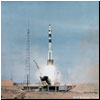 |
Upside down: a strange flight of Soyuz-3 spacecraft Soyuz-3 lifted off on Oct. 26, 1968. Right after entering orbit cosmonaut Georgy Beregovoi began a manual approach to the unpiloted Soyuz-2, but made crucial errors in the darkness of night trying to dock in upside down orientation and severely overusing propellant. |
||||||||||||||||||||||||||||
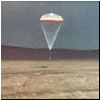 |
Despite the failed docking on Oct. 26, 1968, Soyuz 7K-OK vehicles No. 11 and No. 10 had continued their test missions. Vehicle No. 11, eventually identified as Soyuz-2, landed on October 28, while Georgy Beregovoi continued his flight aboard Soyuz-3, as mission control worked hard to keep busy after a depressing start. |
||||||||||||||||||||||||||||
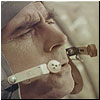 |
Soyuz-3 in orbit: "You make me run like a rabbit"
On October 29, Beregovoi was completing his final full day in orbit, highlighted by a live TV broadcast from orbit, as investigators on the ground delivered their first preliminary verdict on the causes of the spectacular failure of the docking between Soyuz-3 and Soyuz-2 on October 26, which immediately led to political recriminations. |
||||||||||||||||||||||||||||
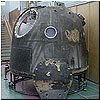 |
Georgy Beregovoi lands aboard Soyuz-3 On October 30, 1968, Georgy Beregovoi made a safe landing in Kazakhstan aboard the descent module of the Soyuz-3 spacecraft after a four-day mission. For the first time since the beginning of flight tests two years earlier and a year and the half after the death of Komarov, the Soyuz 7K-OK spacecraft successfully returned a cosmonaut from orbit. The USSR now had a new transport vehicle. |
||||||||||||||||||||||||||||
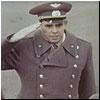 |
Post-flight analysis of the Soyuz-3 mission While the Soviet press hailed the Soyuz-3 mission as a great success of the Soviet cosmonautics and the Kremlin was giving a hero's welcome to its pilot Georgy Beregovoi, behind the scene engineers sifted through data to determine what exactly had gone wrong during the botched rendezvous with Soyuz-2 and what improvements to make on the spacecraft to prevent such situation in the future. |
||||||||||||||||||||||||||||
| Next chapter: Soyuz-4, -5
|
|||||||||||||||||||||||||||||